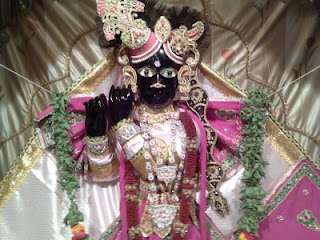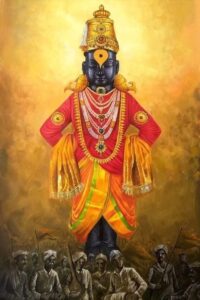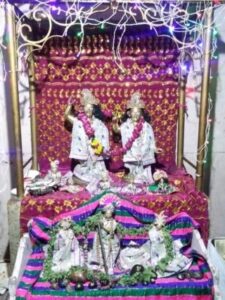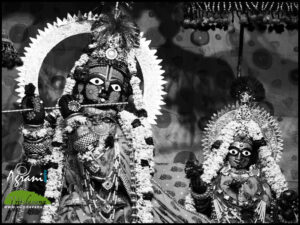Introduction to Banke Bihari Mandir
Banke Bihari Mandir is one of the most revered temples of Lord Krishna, situated in the holy city of Vrindavan in the Mathura district of Uttar Pradesh. This temple attracts a large number of devotees, especially during the month of Shraavana (July-August). The name “Banke Bihari” symbolizes Lord Krishna standing in the Tribhanga posture, meaning “bent in three places,” while “Bihari” refers to the “supreme enjoyer.”
History of Banke Bihari Mandir
The divine image of Bihariji installed in Shri Banke Bihari Mandir was granted to Swami Haridas by the celestial couple, Shyama-Shyam (Krishna and Radha), themselves. The Lord, along with His consort, appeared in person and left behind a black, charming idol before disappearing.
Swami Haridas was born to Shri Ashudhir and Smt. Gangadevi on Radha Ashtami, the eighth day of the bright fortnight of Bhadrapad month, in 1478 A.D., in a small village now known as Haridaspur, near Aligarh, Uttar Pradesh. He was believed to be a reincarnation of Lalita ‘sakhi,’ a close companion of Lord Krishna, which explains his deep spiritual inclinations even from a young age.
Despite being married, Swami Haridas devoted his life to meditation and worship, distancing himself from worldly pleasures. His wife, Harimati, was also spiritually inclined, and realizing her husband’s divine purpose, she attained liberation by entering the flame of a small lamp in his presence, leaving no physical remains.
After this, Swami Haridas moved to Vrindavan, a dense forest at that time, and chose a secluded spot known as Nidhivan to meditate and practice his music, relishing the eternal bliss of divine love and devotion to Lord Krishna. His sadhana involved composing and singing songs in praise of the Lord, through which he experienced the divine pastimes of Krishna and Radha.
The Divine Revelation
One day, Swami Haridas’s disciples, curious about the secluded place where he meditated, entered the Kunj (a grove) with his permission. Instead of witnessing anything ordinary, they were almost blinded by an intense, bright light that filled the entire place. When Swami Haridas himself entered, the divine couple, Krishna and Radha, appeared in person, smiling and casting a spell of charm over everyone present.
The beauty of the divine couple was so overwhelming that Swami Haridas realized the world would not be able to bear such divine splendor. He requested the Lord and Radha to merge into a single form, which they did, creating the black idol of Banke Bihari that is worshipped today. The idol’s charm is so intense that the darshan (viewing) in the temple is never continuous; a curtain is drawn regularly to protect devotees from losing consciousness in the idol’s presence.
The Tradition of Worship
The responsibility for the sewa (service) of Bihariji was entrusted to Goswami Jagannath, the younger brother and principal disciple of Swami Haridas. The tradition of worship continues to this day, performed by the descendants of Jagannath Goswami.
Initially, the deity was installed in a temple near Nidhivan, but a new temple befitting the deity’s glory was constructed in 1862 AD. The temple is an architectural marvel, following the contemporary Rajasthani style.
Unique Sewa Practices
The sewa of Bihariji is performed in three parts every day: Shringar, Rajbhog, and Shayan. Shringar, which includes bathing, dressing, and adorning the deity with jewelry, and Rajbhog (feast) are offered in the forenoon, while Shayan Sewa (sleep) is offered in the evening. Uniquely, the temple does not have a tradition of Mangala (early morning) sewa because Swami Haridas wanted the Lord, in His child-like form, to rest fully without being disturbed early in the morning.
Lessons to be Learned
- Unwavering Devotion: The story of Swami Haridas’s life teaches us the power of unwavering devotion. His complete dedication to Lord Krishna brought the Lord and Radha into direct manifestation, showing that sincere devotion can lead to divine blessings.
- Simplicity and Detachment: Despite his potential for a worldly life, Swami Haridas chose a life of simplicity and spiritual pursuit. This reflects the importance of detachment from material pleasures in the quest for spiritual fulfillment.
- Respect for Tradition: The practices established by Swami Haridas, such as not disturbing the Lord in the morning, underline the significance of respecting and maintaining spiritual traditions.
- Divine Revelation: The transformation of Krishna and Radha into the single form of Banke Bihari symbolizes the unity of divine love and the ability of the divine to manifest in a form that can be appreciated by human devotees.
Prayer to Lord Banke Bihari
O Lord Banke Bihari, the Supreme Enjoyer,
You who enchant the hearts of Your devotees,
Grant me the grace to see You in my heart,
And to serve You with unwavering devotion.
May I be blessed with the vision of Your divine form,
And may my life be filled with the joy of Your presence.
Guide me in the path of righteousness,
And protect me from the illusions of the material world.
O Lord of Vrindavan,
May Your blessings be upon all who seek You,
And may we all find eternal bliss in Your loving gaze.



